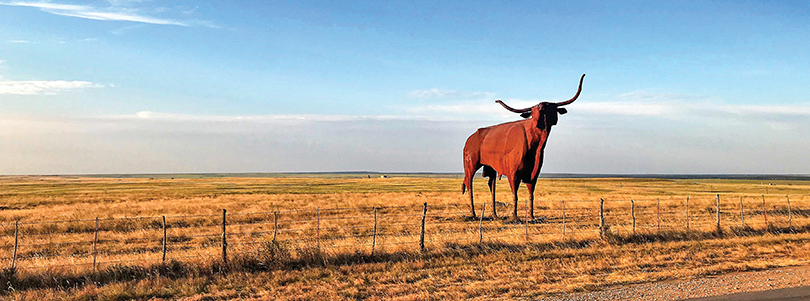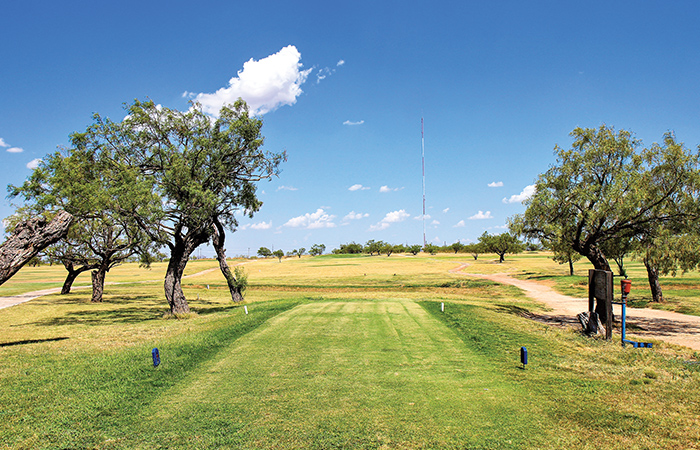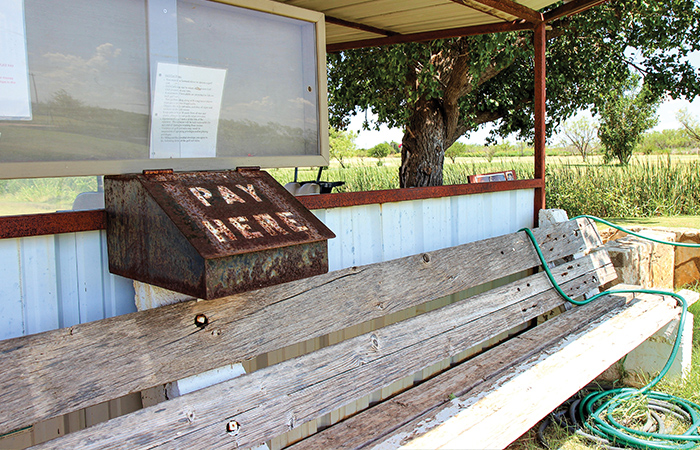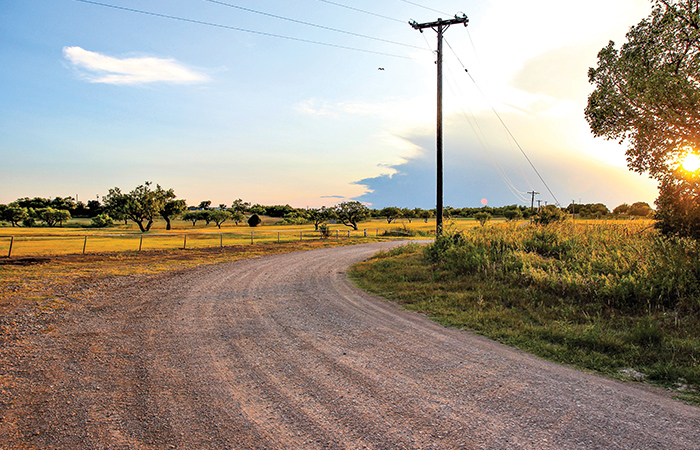Tales From the Back Nine, Part IX – Highway 380 West

Maybe you heard the tall Texas tale of the two frontiersmen who frantically climbed into a small cave by the Clear Fork Brazos River to elude a band of Comanches, arrows whizzing by as the men crawled through a hole in the rock along the steep bank. Whew, safe at last.
But one problem: Their shelter was inhabited by rattlesnakes. With scalpers outside their hiding place and slithering snakes inside, the pioneers faced an epic should-we-stay-or-should-we-go dilemma. They decided to stay pat, sweating out the night in motionless terror.
At daybreak, the snakes were gone. One of the men, known only as Smokey, could finally see the cave’s opening, so he dragged out the lifeless body of his partner, Jeff Turner, felled by fangs in the dark while stretching. Legend has it that when Smokey made it back to Fort Griffin and looked in the mirror, he was shocked to find that his hair had turned white. He spent the rest of his days wandering the plains in virtual seclusion, haunted by that night.
Such tall tales abound in West Texas. The sprawl of sky and space seems to echo with voices of the past.
As the great William Least Heat-Moon wrote in Blue Highways: A Journey into America, “History has a way of taking the merely curious and turning it into significance.”
And so I set out to emulate the mysterious wanderer Smokey, figuring if a one-name loner could weave his way into the fabric of the wild west by sleeping with snakes, then I could certainly carve a chapter of Tales from the Back Nine out of wild golf adventures along a similar path. Would I find a rattlesnake den in my cave?
That was pretty much the last thing on my mind as I loaded my faithful old F-150 with the usual assortment of golf clubs, camping equipment and fishing gear for a journey along.
It’s amazing how quickly a person in DFW can become one with nature, surrounded by open range with easy access to unique golf courses, all sorts of other outdoor activities, landmarks and charming small towns oozing with history.
The beast was hardly warmed up when we turned off I-35 to US-380 West just outside Denton. About 45 minutes later, we were on a gradual two-lane roller coaster. The Texas Forts Trail road leads to eight of the state’s frontier forts where you can follow the legendary footsteps of Robert E. Lee, John Butterfield, Buffalo Hump, Wyatt Earp, Doc Holliday and yes, Smokey. The byway also points to some 20 lakes and seven state parks.
We passed the Fort Richardson State Park and Historic Site near Jacksboro on the way to Graham. The town was settled in 1871 by brothers Gustavus and Edwin Graham, who moved from Kentucky to Texas after the Civil War, buying 125,000 acres in Young County. That same year, the Warren Wagon Train Raid occurred about 12 miles north of Graham.
Like most cities in this region, Graham benefited from railroad service, starting in 1903, and the discovery of oil nearby in 1917. By 1966, Graham had 17 churches, seven schools, a hospital, a radio station, two libraries, three parks, and two newspapers. The population peaked at 9,170 in 1980 but has gradually declined to 8,518 in 2007.
On the afternoon I arrived, it seemed most of the population were at Graham Country Club for the club tournament. No carts were available, so I strolled the grounds. The course has more trees than the three other tracks I would visit combined. With lush fairways, bent greens, and doglegs sweeping through the large old oaks, Graham had a Colonial CC feel. The place was immaculate considering the lack of rain in mid-August. The nine-hole course has two teeing areas for each hole, which changes the course considerably for a second nine. The smooth greens are the highlight of this tight challenging layout, which measures 3,216 yards.
“This place is my baby,” said director of golf JR Bohn walking off the tee after hitting his drive.
Bohn noted the folks at Colonial joke about wanting him to teach them how to grow bent grass. He added that Colonial head professional Dow Finsterwald Jr. comes to Graham every year to go dove hunting with him: “I’ve been here 23 years. I’m the head pro and the superintendent. It keeps me busy, but I love to grow grass.”
Back on 380, we headed to Throckmorton, 35 miles away. We wasted about an hour following Siri’s directions to the golf course. Around and around in circles we went, taking slightly different routes to the same spot — an old abandoned house. Since it was getting late, I called off the search and barked at the beast to take us to Abilene. A few minutes later, when I realized we were off the grid, I apologized to Siri.
No worries. We just stayed on SH-283, mesmerized by the giant orange orb glowing between the trees. Nothing like a West Texas sunset. About halfway to Abilene, there’s a fork in the two-lane highway with SH-183, which takes you to Breckenridge Golf Course. Hurrying to set tent before midnight, we also bypassed Albany Country Club, another nine-hole course. Still without service, I pulled into a drive-through coffee shop. A man was sitting in the parking lot painting a dining table. I asked which way to Abilene.
“Just take a left,” he said, pointing to SH-351, “go over the bridge and then make sure you stay to the left. It’s kinda confusing there.”
In Abilene, we stopped for dinner at Rockin Rollerz, a nice hamburger joint, then onward to Abilene State Park. It was about 10:30 p.m. the last time we did this park on the way to Big Bend in January, and the 17-degree temperature and strong winds forced my departure from the tent. I remember barely seeing the full moon through the trees before I fell asleep in the truck.
When I started setting tent this time, about 11, it was 96 with no wind. A burn ban was in effect, so I didn’t start a fire, and the dense thicket hid the full moon. Just darkness. No other campers. About three hours later, I emerged from the tent sweating and feeling horrible. With the flashlight in my tent, I stumbled toward the truck like a blind man. It was so dark I used my hand to feel my way around the truck. That’s when I heard the rattles. This sound could come from only two things: Either some camper I couldn’t see was walking through the forest playing maracas at 3 a.m., or I was about to step on a rattlesnake. I froze.
Although the sound was loud, I was unsure of its exact location. I figured my best shot at avoiding death was to step backward slowly. A few steps later, my back nudged a sideview mirror. Not going to lie, I totally freaked out. Again, the rattle. This time I kept my hand on the truck as I walked backward, and when I reached the back, the rattling stopped. I made my way around to the driver side, hopped in, cranked the engine, and took off without my tent. Thirty minutes later, I was checking into the Abilene Days Inn.
When I got to the room, I suffered another scare when I glanced at my reflection in the mirror. Staring back at me was the prototype mug shot of a crazed killer. My hair was wild from sweating in a cap all day. Black marks were under my eyes and streaking down my face from wiping away sweat with dirty hands. But, unlike Smokey, at least my hair hadn’t turned white.
A few hours later, we returned to the park to retrieve the tent. I saw no sign of rattlers. I quickly rolled the tent into a ball, threw it in the back seat, and took off for Anson, a 30-minute drive on 277 North.
The town of Anson looked as disheveled as me the night before. Abandoned buildings along the highway leading in and then a couple blocks of car dealerships. The city park area is nestled among several old industrial buildings. With sand beside the hard-packed gravel road, the area looked like the set of an old western movie. I half expected a cowboy with a wide-brimmed hat and hand resting on his holster to challenge me to a duel when I got out of the truck.
But I was thoroughly charmed by Anson Golf Course. It’s a wonder any grass was alive. A garden hose was draped over the marker sign on the first tee. The course, its fairways baking in the 100-degree heat, has only a few scattered trees for shade, but someone has worked hard to maintain the landscaping. Despite the browning fairways, the tee boxes and greens were in surprisingly good shape. The nine-hole muni measures 3,049 yards. You can wail on the driver with no fear.

Anson was built in anticipation of the Texas and Pacific Railroad, but after stores and hotels opened, the T&P decided to reroute through Baird, Abilene and Sweetwater. The town began as Jones City and was declared the county seat in 1881, but changed its name to Anson the next year. No matter. Both names fit. The city was named after Anson Jones, a physician, publisher, founding member of the first Masonic Lodge in Texas and the last president of the Republic of Texas. The San Jacinto veteran had no real tie to the city that bears his name.
Jones County was a busy place back in the pioneer days. It was the site of the frontier military road, Fort Phantom Hill, built in 1851 to guard the military road, and the Butterfield Overland Mail Station, a Civil War patrol point to curb frontier raids by Indians. One thing Anson didn’t have was dancin’ until 1987, when the city council replaced the no-dance ordinance enacted in 1933.
A 20-minute drive on 277/83 North got us to Hamlin, then we took a left just past the Pied Piper Inn on FM-2242. For several miles, all the eye can see is flat farmland, and if you blink you’ll miss the sign tucked behind a barbed-wire fence in the field for Hamlin Country Club, which was founded in 1935.
A gravel road leads through farmland to the nine-hole course measuring 2,950 yards. As was the case in Anson, fees are paid via the honor box near the first tee. The course has invested money to keep the grounds groomed, but the clubhouse is need of repairs. Massive mesquite trees provide definition to the layout and shade for the sun-hardened fairways. This would be considered a pasture course if not for the manicured greens, which rolled smoothly.

The town of Hamlin boomed with the railroad’s arrival in 1902, and then again when oil was discovered in 1928. Businesses included gins, a cottonseed oil mill and then a hospital in 1948. But the population reached its zenith in 1960 (3,791). The current population, however, is estimated to be 2,018.
With high temperatures of 105 both days, even my eyeballs were sunburned when we departed Hamlin. I got whiskey for the beast and ice cream for myself at the Allsup’s convenience store, which are located throughout West Texas, and we set out for home.
But back on 380 and back on the grid, I remembered that we couldn’t find Throckmorton Country Club. We raced the setting sun, turning onto a bumpy road that weaved through fields of swaying native grasses.
The golf course came into view heading down a steep hill, then we took a dirt road around the back of the course, located next to a farm. With the sun getting lower, I pulled over and hopped out to get some photos. Several cows came over, chomping on grass, checking me out.

Not only did Throckmorton CC exist but it turned out to be a diamond in the rough. The course, nestled in a valley behind the lake, rolls gently downhill from the clubhouse. Like most other courses in this region, the fairways were somewhat rugged, but the landscaping was splendid and mature oaks defined the holes — which go up and down the hills.
An epic sunset bathed the layout in an orange hue. The greens were in tip-top shape. One dogleg swept downhill to a green almost hidden by cattails lining the creek. Players cross a bridge to reach the green, located in a secluded enclave, which also features a par-3 surrounded by trees.

Heading home on 380 at night, with a full moon hovering over the horizon, I was struck by the enormity of space. Many of the outposts that sprang up in the late 1800s have been reduced to ghost towns. But today this remote stretch, once the wild frontier where pioneers fought an unforgiving land for survival, provides a glimpse of the past and the ideal setting for wild golf adventures.



